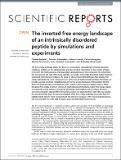| dc.contributor.author | Granata, Daniele | |
| dc.contributor.author | Baftizadeh, Fahimeh | |
| dc.contributor.author | Habchi, Johnny | |
| dc.contributor.author | Galvagnion, Celine | |
| dc.contributor.author | De Simone, Alfonso | |
| dc.contributor.author | Camilloni, Carlo | |
| dc.contributor.author | Laio, Alessandro | |
| dc.contributor.author | Vendruscolo, Michele | |
| dc.date.accessioned | 2015-12-23T16:47:56Z | |
| dc.date.available | 2015-12-23T16:47:56Z | |
| dc.date.issued | 2015-10 | |
| dc.date.submitted | 2015-03 | |
| dc.identifier.issn | 2045-2322 | |
| dc.identifier.uri | http://hdl.handle.net/1721.1/100502 | |
| dc.description.abstract | The free energy landscape theory has been very successful in rationalizing the folding behaviour of globular proteins, as this representation provides intuitive information on the number of states involved in the folding process, their populations and pathways of interconversion. We extend here this formalism to the case of the Aβ40 peptide, a 40-residue intrinsically disordered protein fragment associated with Alzheimer’s disease. By using an advanced sampling technique that enables free energy calculations to reach convergence also in the case of highly disordered states of proteins, we provide a precise structural characterization of the free energy landscape of this peptide. We find that such landscape has inverted features with respect to those typical of folded proteins. While the global free energy minimum consists of highly disordered structures, higher free energy regions correspond to a large variety of transiently structured conformations with secondary structure elements arranged in several different manners, and are not separated from each other by sizeable free energy barriers. From this peculiar structure of the free energy landscape we predict that this peptide should become more structured and not only more compact, with increasing temperatures, and we show that this is the case through a series of biophysical measurements. | en_US |
| dc.description.sponsorship | CINECA | en_US |
| dc.language.iso | en_US | |
| dc.publisher | Nature Publishing Group | en_US |
| dc.relation.isversionof | http://dx.doi.org/10.1038/srep15449 | en_US |
| dc.rights | Creative Commons Attribution | en_US |
| dc.rights.uri | http://creativecommons.org/licenses/by/4.0/ | en_US |
| dc.source | Nature Publishing Group | en_US |
| dc.title | The inverted free energy landscape of an intrinsically disordered peptide by simulations and experiments | en_US |
| dc.type | Article | en_US |
| dc.identifier.citation | Granata, Daniele, Fahimeh Baftizadeh, Johnny Habchi, Celine Galvagnion, Alfonso De Simone, Carlo Camilloni, Alessandro Laio, and Michele Vendruscolo. “The Inverted Free Energy Landscape of an Intrinsically Disordered Peptide by Simulations and Experiments.” Scientific Reports 5 (October 26, 2015): 15449. | en_US |
| dc.contributor.department | Massachusetts Institute of Technology. Department of Chemical Engineering | en_US |
| dc.contributor.mitauthor | Baftizadeh, Fahimeh | en_US |
| dc.relation.journal | Scientific Reports | en_US |
| dc.eprint.version | Final published version | en_US |
| dc.type.uri | http://purl.org/eprint/type/JournalArticle | en_US |
| eprint.status | http://purl.org/eprint/status/PeerReviewed | en_US |
| dspace.orderedauthors | Granata, Daniele; Baftizadeh, Fahimeh; Habchi, Johnny; Galvagnion, Celine; De Simone, Alfonso; Camilloni, Carlo; Laio, Alessandro; Vendruscolo, Michele | en_US |
| dc.identifier.orcid | https://orcid.org/0000-0003-4580-622X | |
| mit.license | PUBLISHER_CC | en_US |
| mit.metadata.status | Complete | |
